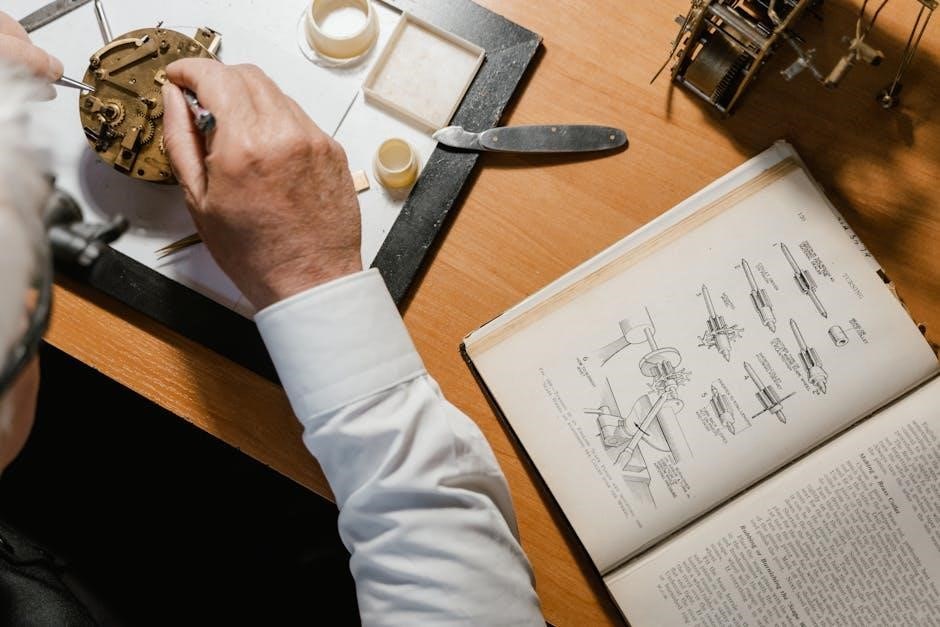Singer 2277 Instruction Manual: A Comprehensive Guide
The Singer 2277 Tradition sewing machine is a versatile tool suitable for both beginners and experienced sewers. This comprehensive guide unlocks its potential, providing clear, concise instructions for seamless operation and creative projects.
The Singer 2277 Tradition is a mechanical sewing machine designed for household use, offering a range of features suitable for beginners and intermediate sewers. With 23 built-in stitches, including basic, decorative, and stretch options, it accommodates diverse sewing tasks. The one-step buttonhole function simplifies creating professional-looking buttonholes, while adjustable stitch length and width provide customization.
The top drop-in bobbin system ensures easy threading and monitoring of thread supply through a clear cover. Included presser feet, such as buttonhole, zipper, and all-purpose, enhance versatility. The robust metal frame ensures stability and durability, complemented by a high sewing speed for efficient project completion. An automatic needle threader saves time and effort, and the free arm facilitates sewing cuffs and collars. The Singer 2277 is a reliable, user-friendly machine for various sewing endeavors.

Key Features and Specifications
Discover the key features of the Singer 2277 Tradition sewing machine. From its 23 built-in stitches to its automatic needle threader, explore its specifications for optimal sewing.
23 Built-In Stitches
The Singer 2277 Tradition sewing machine offers a selection of 23 built-in stitches, catering to a variety of sewing needs. These stitches include essential options for basic sewing tasks like straight stitch and zigzag stitch, ideal for constructing seams and finishing edges. Additionally, the machine features decorative stitches that add embellishments and personalized touches to projects.
Stretch stitches are also incorporated, providing flexibility and durability for sewing on knit fabrics. The range of stitch options accommodates diverse fabric types and project requirements, making the Singer 2277 a versatile tool for both beginners and experienced sewers seeking creative possibilities.
One-Step Buttonhole Function
The Singer 2277 Tradition sewing machine simplifies buttonhole creation with its one-step buttonhole function. This feature allows users to effortlessly create professional-looking buttonholes without manual adjustments. The fully automatic process ensures consistent and precise buttonholes every time, eliminating the guesswork and hassle associated with traditional methods.
This function enhances efficiency and accuracy, making it ideal for both beginners and experienced sewers seeking streamlined projects. With the one-step buttonhole function, users can easily add button closures to garments and other creations with ease and confidence, achieving polished and professional results.
Top Drop-In Bobbin System
The Singer 2277 Tradition sewing machine features a convenient top drop-in bobbin system, simplifying bobbin insertion and removal. This design allows for easy access to the bobbin, making threading quick and hassle-free. The clear cover provides a clear view of the bobbin thread supply, enabling users to monitor thread levels and prevent unexpected run-outs during sewing.
The top drop-in system enhances user convenience, especially for beginners. It eliminates the need to remove the accessory tray to access the bobbin. This system contributes to a seamless sewing experience, saving time and effort while ensuring smooth operation.

Basic Operations
Understanding the basic operations of the Singer 2277 is essential for successful sewing. This section covers threading, bobbin winding, and stitch selection, providing a foundation for both beginner and experienced sewers.
Threading the Machine
Threading the Singer 2277 sewing machine correctly is crucial for achieving consistent and professional stitching results. Begin by raising the presser foot and positioning the thread spool on the spool pin, ensuring it unwinds smoothly. Guide the thread through the thread guides, following the numbered diagram on the machine.
Next, thread the tension discs, ensuring the thread is properly seated between them. Continue guiding the thread down to the needle area, and use the automatic needle threader, if available, to easily thread the needle eye. Alternatively, manually thread the needle from front to back.
Finally, draw the thread through the needle and under the presser foot, leaving a few inches of thread. Correct threading prevents thread tangling and ensures smooth fabric feeding for quality seams.
Bobbin Winding
Proper bobbin winding is essential for balanced stitches with the Singer 2277. Begin by placing an empty bobbin onto the bobbin winder spindle. Loosen the needle’s handwheel to disengage the sewing mechanism. Guide the thread from the spool through the bobbin winding tension disc, ensuring it’s held firmly.
Wind the thread around the bobbin several times to secure it. Push the bobbin winder spindle to the right, engaging the winding mechanism. Depress the foot pedal to start winding. Allow the bobbin to fill evenly, stopping when it reaches capacity.
Trim the excess thread, push the bobbin winder spindle to the left, and remove the filled bobbin. Tighten the needle’s handwheel to re-engage the sewing mechanism before sewing. An evenly wound bobbin ensures consistent thread delivery during sewing.
Stitch Selection and Adjustment
The Singer 2277 boasts 23 built-in stitches, easily selectable via the stitch selector dial; Rotate the dial to choose from basic, decorative, and stretch stitches, each suited for different fabric types and sewing tasks. Understanding stitch functions is key to achieving desired results.
Adjust stitch length using the stitch length dial. Shorter lengths are ideal for fine fabrics and detailed work, while longer lengths suit heavier materials and basting. Experiment with different lengths to find the perfect setting for your project.
Similarly, adjust stitch width for zigzag stitches to control the breadth of the stitch. Wider stitches create bolder effects, while narrower stitches offer more subtle detailing. Practice on scrap fabric to master these adjustments. Correct settings prevent puckering.

Troubleshooting
Encountering issues with your Singer 2277? This section addresses common problems, offering practical solutions for needle breakage, thread tangling, and tension adjustments. Resolve sewing machine hiccups quickly and efficiently.
Needle Breakage Causes
Needle breakage is a frustrating issue. Several factors contribute to this problem. Using the wrong needle for the fabric is a primary cause. A thick fabric requires a thicker needle; The needle may be set too low or the fabric not properly guided. An incorrectly inserted bobbin case may also contribute. Ensure you are using the correct needle size for your material. Refer to the needle packaging for fabric suitability. Regularly check the needle’s condition and replace it after approximately 7 to 9 hours of use to prevent unexpected breaks during sewing projects, ensuring smooth operation.
Thread Tangling Issues
Thread tangling is a common sewing problem that can disrupt your workflow. Ensure the thread is correctly threaded through all guides and tension discs. Check that the thread spool is positioned correctly and not tangled. Incorrect threading is a frequent culprit. The thread tension may also need adjustment. If the stitches are too loose or tight, adjust the tension control dial. Verify the bobbin is correctly inserted and wound; Clean the machine regularly to remove lint and debris, preventing thread snags. Using quality thread can minimize tangling issues. Regularly inspect and maintain your machine.
Tension Adjustment Problems
Proper thread tension is crucial for quality stitches. If your stitches are too loose, increase the tension by turning the tension control dial. If they are too tight, decrease the tension. Ensure the machine is correctly threaded, as incorrect threading affects tension. Use the correct bobbin and ensure it’s properly inserted. Test different tension settings on scrap fabric to find the optimal setting for your material; Clean the machine regularly, as lint can interfere with tension. Also, verify that you are using the appropriate thread for the fabric, as heavy fabrics may require higher tension settings.

Maintenance and Care
Regular maintenance ensures your Singer 2277 sewing machine operates smoothly. Proper cleaning, oiling, and needle replacement extend its lifespan and maintain performance, preventing issues and ensuring consistent stitch quality.
Cleaning and Oiling
To ensure the longevity and optimal performance of your Singer 2277 sewing machine, regular cleaning and oiling are essential. Begin by disconnecting the machine from the power source. Use a soft brush to remove lint and dust from the bobbin area, feed dogs, and other accessible parts. A lint brush or vacuum attachment can also be helpful.
For oiling, use sewing machine oil sparingly on designated points as indicated in the instruction manual. Typically, these include the bobbin race, hook, and other moving parts. Avoid over-oiling, as this can attract more dust and lint.
After oiling, run the machine briefly on a scrap of fabric to absorb any excess oil. Regularly cleaning and oiling your machine will prevent jams, reduce wear, and maintain smooth operation, ensuring your sewing projects are always a success. Always consult your manual for the recommended oiling points.
Needle Replacement Guide
Replacing the needle on your Singer 2277 is a simple yet crucial maintenance task. First, turn off and unplug your sewing machine for safety. Loosen the needle clamp screw, usually located near the needle, using the provided screwdriver. Remove the old needle, noting its orientation.
Insert the new needle with the flat side facing the back. Push the needle up as far as it will go into the needle clamp. Tighten the needle clamp screw securely to hold the needle in place. Ensure the needle is correctly aligned to prevent breakage or skipped stitches.
Choosing the correct needle size for your fabric is also essential. Use finer needles for delicate fabrics and thicker needles for heavier materials. Regularly replacing your needle ensures optimal stitch quality and protects your fabric from damage, contributing to successful and enjoyable sewing projects. Consult your manual for specific needle recommendations.
Frequently Asked Questions (FAQs)
Confused about something? This section addresses common queries about the Singer 2277 Tradition. Find quick solutions and helpful tips to enhance your sewing experience and keep your machine running smoothly.
Centering the Needle Position
Is your needle off-center, causing issues with straight stitches? Returning the needle to the center of the presser foot on the Singer 2277 is a simple fix. First, ensure the machine is off and unplugged for safety. Locate the stitch width dial, usually labeled with numbers or symbols on the front of the machine. Turn this dial to the center position. This action should align the needle in the center. Turn the machine back on and select the straight stitch mode to test. If the needle is still off, double-check the dial’s position. This adjustment ensures accurate and consistent stitching.
Adjusting for Fabric Type
Achieving optimal stitch quality with your Singer 2277 requires adjusting settings based on the fabric. For light cotton, ensure the needle is appropriate; use a finer needle for thin, filmy fabrics. Adjust the thread tension; too high can cause puckering. Experiment with stitch length and width; shorter stitches work well for delicate fabrics. Ensure proper threading and bobbin insertion. The presser foot pressure may also need adjustment; reduce it for delicate materials. Stabilize the fabric if needed to prevent jamming. Regularly check and adjust these settings to ensure smooth, even stitches, regardless of the material being sewn.
